Piotr Hartmann1, 2, *Teresa Jackowska1, 2, Paulina Przybysz1, 2, Bartosz Siewert3, Anna Kozłowska3
Analysis of hospitalisation of children at the Hospital Emergency Department in 2014 – own observations**
Analiza hospitalizacji dzieci w Szpitalnym Oddziale Ratunkowym w 2014 roku – obserwacje własne
1Department of Pediatrics, Centre of Postgraduate Medical Education, Warsaw
Head of Department: prof. Teresa Jackowska, MD, PhD
2Department of Pediatrics, Father Jerzy Popiełuszko “Bielański” Hospital, Independent Public Health Care Institution in Warsaw
Head of Department: prof. Teresa Jackowska, MD, PhD
3Student Research Circle, Department of Pediatrics, Centre of Postgraduate Medical Education, Warsaw
Head of Circle: Piotr Hartmann, MD
Streszczenie
Wstęp. W szpitalnym oddziale ratunkowym (SOR) ma miejsce wstępna diagnostyka oraz podejmowane jest leczenie w zakresie niezbędnym dla stabilizacji funkcji życiowych u osób, które znajdują się w stanie nagłego zagrożenia zdrowotnego. Pacjenci mogą zgłaszać się do SOR-u bez skierowania, co w sytuacji braku definicji „nagłego zagrożenia zdrowotnego” może powodować nadużywanie SOR-u.
Cel pracy. Celem pracy była analiza hospitalizacji pacjentów w SOR-ze w zależności od wieku pacjentów, sposobu zgłoszenia się i wypisu oraz sezonowości i godziny przyjęcia.
Materiał i metody. Grupę badaną stanowiło 6373 dzieci przyjętych w SOR-ze Szpitala Bielańskiego w Warszawie w 2014 roku. Średni wiek pacjentów wynosił 4,5 roku (od 5 dni do 18 lat).
Wyniki. 55% pacjentów (3499/6373) było skierowanych do szpitala przez lekarza rejonowego, 13% (811/6373) przez Pogotowie Ratunkowe (PR), 1% (93/6373) przez chirurga dziecięcego. 31% (1970/6373) zgłosiło się bez skierowania. Hospitalizacji wymagało 36,8% (2346/6373) wszystkich pacjentów. U 60,6% (3861/6373) nie stwierdzono wskazań do leczenia szpitalnego. Spośród pacjentów, którzy zgłosili się do szpitala ze skierowaniem, hospitalizacji w oddziale pediatrycznym wymagało 40,4% (1414/3499) dzieci przywiezionych przez PR 45% (365/811), a 27,3% (538/1970) zgłaszający się bez skierowania. Średni czas pobytu pacjentów w SOR-ze wynosił 128 minut (od 2 do 873 minut). 21,2% (1349/6373) pacjentów przyjmowano w godzinach 18-21.
Wnioski. Zarówno wśród skierowanych do szpitala, jak i zgłaszających się bez skierowania hospitalizacji wymaga mniej niż połowa (odpowiednio 40,4 i 27,2%) pacjentów. Dwukrotnie więcej pacjentów zgłasza się w miesiącach zimowych niż letnich. Najwięcej pacjentów zgłasza się do SOR-u tuż po zakończeniu pracy poradni rejonowej.
Summary
Introduction. The Hospital Emergency Department (ED) is the place of diagnostics and treatment within the scope necessary to stabilise vital functions in persons in the condition of sudden threat to life. Patients may report at the Hospital Emergency Department without a referral, which in the situation of lack of the definition of “a sudden threat to life” may result in overusing Hospital Emergency Departments.
Aim. The aim of the study was to analyse the hospitalisation of patients at the Hospital Emergency Department depending on the patients’ age, mode of admission and discharge, seasonality and time of admission.
Material and methods. The group consisted of 6373 children admitted to the Hospital Emergency Department of the Bielański Hospital, Warsaw in 2014. The average age of the patients was 4.5 (5 days to 18 years old).
Results. 55% of the patients (3499/6373) were referred to hospital by their General Practitioner (GP), 13% (811/6373) by Emergency Medical Services (EMS), 1% (93/6373) by paediatric surgeons. 31% (1970/6373) of the patients came to the hospital without any referral. Hospitalisation turned out necessary in the case of 36.8% (2346/6373) patients. In 60.6% (3861/6373) of the cases there were no indications to perform hospital treatment. Among the patients who came to the hospital with a referral, 40.4% (1414/3499) required hospitalisation at the paediatrics department, 45% (365/811) of those brought by the EMS and 27.3% (538/1970) of those who came without a referral. The average time spent by patients at the Hospital Emergency Department amounted to 128 minutes (from 2 to 873 minutes). 21.2% (1349/6373) of the patients were examined between 6 p.m. and 9 p.m.
Conclusions. In both groups, with or without a referral to the hospital, fewer than half of the patients required hospitalisation (40.4 and 27.2%, respectively). During winter months, there are twice as many patients coming as during the summer. The majority of patients report at the Hospital Emergency Department right after the end of the working hours of the district clinics.

Introduction
Pursuant to the Regulation of the Minister of Health of 3 November 2011 (1) the Hospital Emergency Department (ED) is the place of diagnostics and treatment within the scope necessary to stabilise vital functions in persons in the condition of sudden threat to life. Hospital Emergency Departments are organised at hospitals equipped with [ndash] at least [ndash] General Surgery Department with traumatic part (and/or Child Surgery Department), Internal Medicine Department (and/or Paediatrics Department), Anaesthesiology Department and Intensive Care, Diagnostic Imaging Laboratory. Patients may report at the Hospital Emergency Department without a referral, which in the situation of lack of the definition of “a sudden threat to life” may result in overusing Hospital Emergency Departments in situations, when medical assistance could be obtained at Primary Care or Night Medical Advice.
At the Bielański Hospital in Warsaw, the Hospital Emergency Department has a separate part for children aged 0-18. In the case hospitalisation is necessary, children are admitted to one Paediatrics Department.
Aim
The objective of the paper is to analyse:
1. The number of patients requiring hospitalisation at the Paediatrics Department depending on the reasons for visiting the Hospital Emergency Department.
2. Period and seasonal nature of admitting to the Hospital Emergency Department.
3. Period of hospitalisation at the Hospital Emergency Department.
Material and methods
Sample group comprised of 6373 patients, 48% were girls (3040/6373) and 52% were boys (3333/6373), to the age of 18, admitted to the Hospital Emergency Department of the Bielański Hospital in Warsaw from 1 January to 31 December 2014 (one calendar year). The average age of the patients amounted to 4.54 (5 days to 18 years old), median was 2.64. Figure 1 shows the number of patients in particular age groups. The majority [ndash] namely as many as 26.8% of the patients (1710/6373) were at the age of 1, and over half [ndash] namely 53.6% (3418/6373) up to the age of 3 (fig. 1).
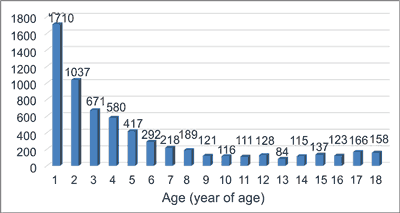
Fig. 1. Number of patients admitted to the Hospital Emergency Department depending on their age
The analysis covered all the medical histories of patients admitted to the Hospital Emergency Department. The age of the patients, mode of admission (referral, without a referral), time of admission (date and hour), period of stay at the Hospital Emergency Department and further procedures were analysed.
Results
In the research group, 55% of the children (3499/6373) were referred to the hospital by a doctor, 31% (1970/6373) came to the Hospital Emergency Department without a referral, 13% (811/6373) were brought by the Emergency Medical Service (EMS) and 1% (93/6373) was referred to be consulted by a paediatric surgeon (fig. 2). The majority, 61% (1043/1710) of the patients referred to the hospital were in their first year of age, and the lowest number, 40% (116/289) at the age of 16 and 17. Emergency Medical Service brought from 8% (137/1710) to 31% (51/166) of the patients (in the first year of age and at the age of 17, respectively) (fig. 3).
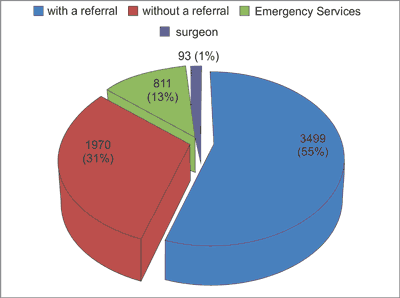
Fig. 2. Number of patients depending on the manner of reporting at the Hospital Emergency Department (N = 6,373)
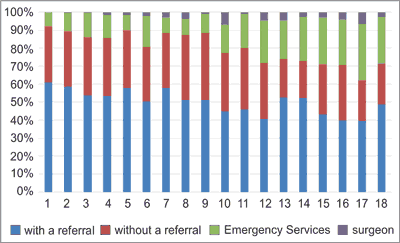
Fig. 3. Number of patients depending on the manner of being admitted to the Hospital Emergency Department, consecutive years of age
Out of the whole group, hospitalisation was required in the case of 36.8% (2346/6373) of the patients and in 60.6% (3861/6373) no indications to hospitalisation were observed. In 2% (127/6373) of the cases, parents expressed no consent for hospitalisation, 0.6% (39/6373) of the children left the Hospital Emergency Department prior to the completion of medical procedures (fig. 4).
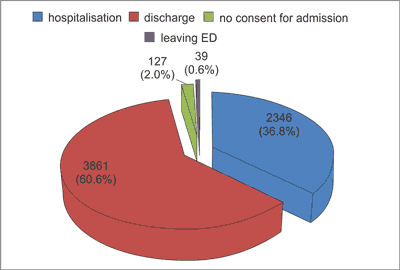
Fig. 4. Manner of patients’ discharge from the Hospital Emergency Department
From among patients having a referral admitted to the Hospital Emergency Department, hospitalisation at the Paediatrics Department was required in the case of 40.4% (1414/3499) of the patients. 45% (365/811) of the patients from the ones brought by the Emergency Medical Service. Hospitalisation at the Paediatrics Department was required in the case of those admitted without a referral or directed for consultation by a paediatrician by the surgeon by 27.3% (538/1970) and 31% (29/93) of the patients, respectively (fig. 5).
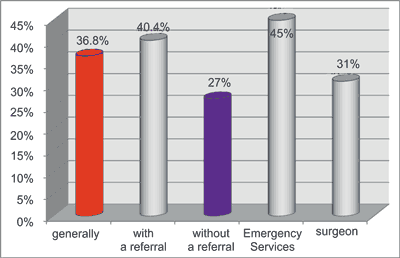
Fig. 5. Rate of children admitted to the Paediatrics Department depending on the mode of coming to the Hospital Emergency Department
Powyżej zamieściliśmy fragment artykułu, do którego możesz uzyskać pełny dostęp.
Mam kod dostępu
- Aby uzyskać płatny dostęp do pełnej treści powyższego artykułu albo wszystkich artykułów (w zależności od wybranej opcji), należy wprowadzić kod.
- Wprowadzając kod, akceptują Państwo treść Regulaminu oraz potwierdzają zapoznanie się z nim.
- Aby kupić kod proszę skorzystać z jednej z poniższych opcji.
Opcja #1
29 zł
Wybieram
- dostęp do tego artykułu
- dostęp na 7 dni
uzyskany kod musi być wprowadzony na stronie artykułu, do którego został wykupiony
Opcja #2
69 zł
Wybieram
- dostęp do tego i pozostałych ponad 7000 artykułów
- dostęp na 30 dni
- najpopularniejsza opcja
Opcja #3
129 zł
Wybieram
- dostęp do tego i pozostałych ponad 7000 artykułów
- dostęp na 90 dni
- oszczędzasz 78 zł
Piśmiennictwo
1. Rozporządzenie Ministra Zdrowia z dnia 3 listopada 2011 r. w sprawie szpitalnego oddziału ratunkowego (Dz. U. Nr 237, poz. 1420, z późn. zm.).
2. Giacalone T, Vanelli M, Zinelli C et al.: One year experience AT the Emergency Unit of the Children’s Hospital of Parma. Acta Bio Medica 2003; 74: 34-37.
3. Ogilvie D: Hospital based alternatives to acute paediatric admissionn a systematic review. Arch Dis Child 2005; 90: 138-142.
4. Randall Bond G, Wiegand C: Estimated use of a Pediatric Emergency Department Observation Unit. Annals of Emergency Medicine 1997; 29(6): 739-742.
5. Akenroye A, Thurm CW, Neuman MI et al.: Prevalence and predictors of return visits to Pediatric Emergency Departments. Journal of Hospital Medicine 2014; 9(12): 779-787.





